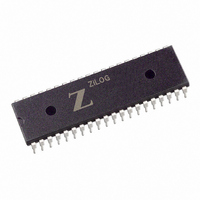Z85C3008PSG Zilog, Z85C3008PSG Datasheet - Page 290

Z85C3008PSG
Manufacturer Part Number
Z85C3008PSG
Description
IC 8MHZ Z8500 CMOS SCC 40-DIP
Manufacturer
Zilog
Series
SCCr
Specifications of Z85C3008PSG
Processor Type
Z80
Features
Error Detection and Multiprotocol Support
Speed
8MHz
Voltage
5V
Mounting Type
Through Hole
Package / Case
40-DIP (0.620", 15.75mm)
Maximum Operating Temperature
+ 70 C
Minimum Operating Temperature
0 C
Mounting Style
Through Hole
Cpu Speed
8MHz
Digital Ic Case Style
DIP
No. Of Pins
40
Supply Voltage Range
5V
Operating Temperature Range
0°C To +70°C
Svhc
No SVHC (18-Jun-2010)
Base Number
85
Rohs Compliant
Yes
Clock Frequency
8MHz
Lead Free Status / RoHS Status
Lead free / RoHS Compliant
Other names
269-3930
Q2456016A
Z85C3008PSG
Q2456016A
Z85C3008PSG
Available stocks
Company
Part Number
Manufacturer
Quantity
Price
Company:
Part Number:
Z85C3008PSG
Manufacturer:
ZILOG
Quantity:
6 100
Company:
Part Number:
Z85C3008PSG
Manufacturer:
Zilog
Quantity:
6
Company:
Part Number:
Z85C3008PSG
Manufacturer:
TOSHIBA
Quantity:
3 500
Part Number:
Z85C3008PSG
Manufacturer:
ZILOG
Quantity:
20 000
Company:
Part Number:
Z85C3008PSGSCC
Manufacturer:
ZILOG
Quantity:
2
- Current page: 290 of 317
- Download datasheet (4Mb)
UM010901-0601
Load Capacitors
The effects/purposes of the load caps are:
Cap C2 combined with the amp output resistance provides
a small phase shift. It also provides some attenuation of
overtones.
Cap C1 combined with the crystal resistance provides
additional phase shift.
These two phase shifts place the crystal in the parallel
resonant region of Figure 3.
Crystal manufacturers specify a load capacitance number.
This number is the load seen by the crystal which is the
series combination of C1 and C2, including all parasitics
(PCB and holder). This load is specified for crystals meant
to be used in a parallel resonant configuration. The effect
on startup time; if C1 and C2 increase, startup time
increases to the point at which the oscillator will not start.
Hence, for fast and reliable startup, over manufacture of
large quantities, the load caps should be sized as low as
possible without resulting in overtone operation.
Amplifier Characteristics
The following text discusses open loop gain vs. frequency,
open loop phase vs. frequency, and internal bias.
Probe (in)
EXTAL (Z180)
RTxCB (SCC)
1V P-P/Sine
Frequency
Generator
470 pf
Figure 6. Gain Measurement
Inputs: 10k To Vcc)
Vcc
(All Unused
Under Test
Supply
Power
Open Loop Gain vs. Frequency over lot, VCC, Process
Split, and Temp. Closed loop gain must be adequate to
start the oscillator and keep it running at the desired
frequency. This means that the amplifier open loop gain
must be equal to one plus the gain required to overcome
the losses in the feedback path, across the frequency band
and up to the frequency of operation. This is over full
process, lot, V
measuring the open loop gain is not sufficient; the losses
in the feedback path (crystal and load caps) must be
factored in.
Open Loop Phase vs. Frequency. Amplifier phase shift at
and near the frequency of interest must be 180 degrees plus
some, minus zero. The parallel configuration allows for
some phase delay in the amplifier. The crystal adjusts to this
by moving slightly down the reactance curve (Figure 3).
Internal Bias. Internal to the IC, there is a resistor placed
from output to input of the amplifier. The purpose of this
feedback is to bias the amplifier in its linear region and to
provide the startup transition. Typical values are 1M to
20M ohms.
I.C.
Gnd
CC
, and temperature ranges. Therefore,
XTAL (Z180)
SYNCB (SCC)
22 pf
On-Chip Oscillator Design
Probe
(out)
Application Note
6-155
1
Related parts for Z85C3008PSG
Image
Part Number
Description
Manufacturer
Datasheet
Request
R

Part Number:
Description:
Manufacturer:
Zilog, Inc.
Datasheet:

Part Number:
Description:
Cmos Scc Serial Communications Controller
Manufacturer:
ZiLOG Semiconductor
Datasheet:

Part Number:
Description:
Communication Controllers, ZILOG INTELLIGENT PERIPHERAL CONTROLLER (ZIP)
Manufacturer:
Zilog, Inc.
Datasheet:

Part Number:
Description:
KIT DEV FOR Z8 ENCORE 16K TO 64K
Manufacturer:
Zilog
Datasheet:

Part Number:
Description:
KIT DEV Z8 ENCORE XP 28-PIN
Manufacturer:
Zilog
Datasheet:

Part Number:
Description:
DEV KIT FOR Z8 ENCORE 8K/4K
Manufacturer:
Zilog
Datasheet:

Part Number:
Description:
KIT DEV Z8 ENCORE XP 28-PIN
Manufacturer:
Zilog
Datasheet:

Part Number:
Description:
DEV KIT FOR Z8 ENCORE 4K TO 8K
Manufacturer:
Zilog
Datasheet:

Part Number:
Description:
CMOS Z8 microcontroller. ROM 16 Kbytes, RAM 256 bytes, speed 16 MHz, 32 lines I/O, 3.0V to 5.5V
Manufacturer:
Zilog, Inc.
Datasheet:

Part Number:
Description:
Low-cost microcontroller. 512 bytes ROM, 61 bytes RAM, 8 MHz
Manufacturer:
Zilog, Inc.
Datasheet:

Part Number:
Description:
Z8 4K OTP Microcontroller
Manufacturer:
Zilog, Inc.
Datasheet:

Part Number:
Description:
CMOS SUPER8 ROMLESS MCU
Manufacturer:
Zilog, Inc.
Datasheet:

Part Number:
Description:
SL1866 CMOSZ8 OTP Microcontroller
Manufacturer:
Zilog, Inc.
Datasheet:











